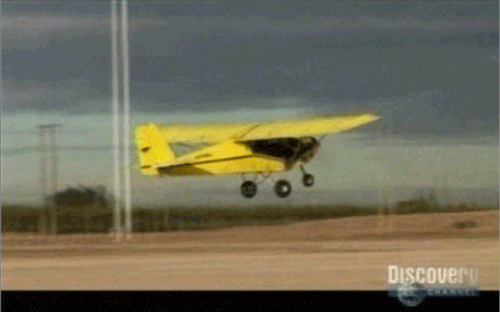So, after months and months of online discussion, Mythbusters Jamie and Adam put the physics where the rubber meets the road.
Literally.
Almost two years ago, I (and most of the internet, it seems) saw a thought question at Kottke.org regarding an airplane on a giant conveyor belt. If the belt moved the exact same speed as the airplane’s wheels – only in the opposite direction – would the plane take off? Well, the answer was immediately clear to me, but that’s for the sole reason of I took several semesters of statics, dynamics, and physics in college. I knew immediately that the plane would take off, without any question. I did my best to clearly explain why this was the case in the ensuing discussion on Jason Kottke’s website1.

Well, last night, I (and Kottke, along with a lot of others) were vindicated as we watched a little yellow, single seat ultralight take off from a 2,000 foot long conveyor belt on a new episode of Mythbusters.
Now, as just a brief – and parenthetical – afterthought: it always feels good to be proven right. However, one of the most awesome experiences in science is when all common sense tells you one thing, but the numbers and scientific logic tell you the opposite. In that case, when a empirical result supports the unlikely or seemingly impossible, it is a marvelous and wonderful surprise. Think about all the really cool experiments you ever saw in science class or on Mr. Wizard, and I’ll bet they fit into that latter case. What you thought couldn’t happen does indeed happen right before your eyes. That very thing has made many a person fall in love with science for the rest of their lives and I sincerely hope that this experiment did the same for a lot of people last night.

In the meantime: I told you so!
- Kottke has really taken some ownership of this question, too. He even live-blogged last night’s episode. I, unfortunately, had to TiVo it and watch it this morning. Hence, the somewhat late post of mine. [↩]
Uh, yeah. So I know there are probably a dozen more important things I should have been blogging about for the past month. There’s just been too much going on. The short & skinny? We’ve moved to TN, we’re all doing fine, work is good for both of us, you’ll all get updates very soon.
In the meantime, you get stuff like this to entertain you…
Ok. I never had any courses in statics, dynamics or even physics in college, but I still can’t believe people would even question this. I’ve been hearing about this all day today. How did this make it to Mythbusters? This is just common sense. The plane is pushing against the air. What’s underneath has nothing to do with it. Seems to me, the only thing the conveyor belt is doing is creating a tiny bit more resistance due to the friction in the wheel bearings.
In the words of GOB Bluth, COME ON!!
It would have at least been slightly more interesting to have a fan blowing toward the front of the plane at the same speed as the propeller (I mean wind force, not RPM).
Of course, the plane would still take off; it just wouldn’t move foreward.
Well, I was trying to be polite, but yeah — it kind of shocks me, too, that people are being so insistent on the wrong answer. Basically, the wheels spin twice as fast as they would during a normal take-off (if they are remotely decent wheels, they offer negligible increased resistance). However, you — perhaps more than the average individual — have a fairly innate sense of mechanics.
People keep trying to (either intentionally or not) mis-represent the initial problem statement as being something else. Now, as for the fan, that would certainly change the situation as it would introduce outside forces onto the plane.
Oh come on Jason, it’s the freaking Mythbusters, not NASA. They’ve screwed up tons of experiments. Go back and watch it again, that aircraft was not stationary. That aircraft was moving forward on the track the entire time. All you have to do is pay attention to it’s motion in relation to the cones placed along the track. Until some egghead from the JPL steps up and does this for real (with a real conveyor belt as the myth stipulated and not a track dragged my a vehicle that did not maintain a constant speed), the jury is still out.
You dolts. The prop was pulling the plane forward through space, and pushing air over the wings, creating LIFT.
The plane will always take off at a particular speed through the air. Air speed is not to be confused with speed over the ground, which is totally irrelevant.
The prop gave the plane the necessary forward airspeed to become airborne, and the expected result was seen: liftoff.
If you think common sense conflicted with science, then you’re not really familiar with either. The result was completely predictable.
The wheels have NOTHING whatsoever to do with either propulsion or lift.
Will — I fully admit that the Mythbusters are hardly the equivalent of a peer-review journal. However, they routinely re-visit problems with experiments and do a pretty good job of testing and I honestly don’t see that the results would be any different on a more controlled conveyor belt.
Sue — I appreciate your enthusiasm, but this isn’t the World Wild Web and calling people names isn’t welcome here (especially when we all know one another but not you). This argument has been going around for two years now and leaving a less-than-pleasant comment here isn’t going to end anything. Be nice or move on.
I missed part of that episode and was just wondering what the make and model of the yellow ultralight was?